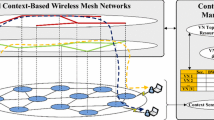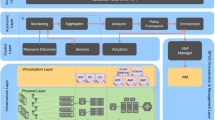Abstract
Wireless Mesh Networks (WMNs) have gained increasing attention as an attractive means to provide connectivity in complement to access as offered by regular Internet Service Providers (ISPs). Such a grass-root technique, however, often suffers from detrimental operating conditions and poor quality. Network virtualization, on the other hand, has been widely advocated as a possibility to overcome what has often been referred to as the ossification of the Internet. Combining the concept of network virtualization with WMN technology, therefore, appears to be promising and desirable. It is envisioned that well managed multiple Virtual Networks (VNs) may overcome shortcomings of WMNs on the one hand, and extend the reach of the Internet beyond its current confinement into the realm and control of the user on the other hand. In this paper, we argue for a context-based approach for an effective means to extend multi-VNs from the Internet domain into WMN environments. We describe both mobility and preferences as context models in order to create virtualized WMNs based on these types of context models. As a result, it is envisioned to achieve a comprehensive connectivity coverage, accompanied by high assurance in network quality. We further present a distributed solution to manage multi-VNs, and a mobility-aware context use case to demonstrate the usefulness of our approach.
Similar content being viewed by others
References
Akyildiz, I., Wang, X., & Wang, W. (2005). Wireless mesh networks: a survey. Computer Networks, 47(4), 445–487.
AN. Information available at http://www.ambient-networks.org/.
Mathieu, B., Song, M., Galis, A., Cheng, L., Jean, K., Ocampo, R., Brunner, M., & Cassini, M. (2007). Self-management of context-aware overlay ambient networks. In Proceedings of 10th IFIP/IEEE international symposium on integrated network management.
Mathieu, B., Song, M., Galis, A., Cheng, L., Jean, K., Ocamo, R., Lai, H., Brunner, M., Stiemerling, M., Cassini, M., & Kampmann, M. (2007). Autonomic management of context-aware ambient overlay networks. In Proceedings of ChinaCom.
Jean, K., Cheng, L., Ocampo, R., & Galis, A. (2006). Contextualisation of management overlays in ambient networks. In Proceedings of international multi-conference on computing in the global information technology.
Cheng, L., Ocampo, R., Jean, K., & Galis, A. (2006). Service-aware overlay adaptation in ambient networks. In Proceedings of international multi-conference on computing in the global information technology.
Al-Oqily, I., & Karmouch, A. (2007). Policy-based context-aware overlay networks. In Proceedings of information infrastructure symposium, GIIS.
Al-Oqily, I., & Karmouch, A. (2007). Automating overlay networks management. In Proceedings of 21st international conference on advanced networking and applications, AINA.
Neto, A., Sargento, S., Logota, E., Antoniou, J., & Pinto, F. (2009). Multiparty session and network resource control in the context casting (c-cast) project. In Proceedings of 2nd international workshop on future multimedia networking, FMN.
PlanetLab. An open platform for developing, deploying, and accessing planetary-scale services. Information available at http://www.planet-lab.org/.
VINI. A virtual network infrastructure. Information available at http://www.vini-veritas.net/.
GENI. Global environment for network innovations. Information available at http://www.geni.net/.
Feamster, N., Gao, L., & Rexford, J. (2007). How to lease the Internet in your spare time. ACM SIGCOOM, 37(1), 61–64.
Subramanian, A., Buddhikot, M., & Miller, S. (2006). Interference aware routing in multi-radio wireless mesh networks. In Proceedings of 2nd workshop on wireless mesh networks, WiMesh.
Staub, T., Braun, T. (2008). Atom: adaptive transport over multipaths in wireless mesh networks. In Proceedings of 2nd ERCIM workshop on eMobility.
Hu, P., Robinson, R., Portmann, M., & Indulska, J. (2008). Context-aware routing in wireless mesh networks. In Proceedings of CEASEMANS.
Lin, T., Wang, C., & Lin, P. C. (2008). A neural-network-based context-aware handoff algorithm for multimedia computing. ACM Transactions on Multimedia Computing, Communications and Applications, 4(3), 17–23.
Oh, M. (2008). An adaptive routing algorithm for wireless mesh networks. In Proceedings of 10th international conference on advanced communication technology, ICACT.
Määttä, J., & Bräysy, T. (2009). A novel approach to fair routing in wireless mesh networks. EURASIP Journal on Wireless Communications and Networking.
Langar, R., Bouabdallah, N., & Boutaba, R. (2009). Mobility-aware clustering algorithms with interference constraints in wireless mesh networks. Computer Networks, 53(1), 25–44.
Ren, M., Liu, C., Zhao, H., Zhao, T., & Yan, W. (2007). Memo: an applied wireless mesh network with client support and mobility management. In Proceedings of global telecommunications conference, GLOBECOM.
Fan, Y., Zhang, J., & Shen, X. (2008). Mobility-aware multi-path forwarding scheme for wireless mesh networks. In Proceedings of wireless communications and networking conference, WCNC.
Couto, L. A., Barraca, J. A. P., Sargento, S., & Aguiar, R. L. (2009). FastM in WMN: a fast mobility support extension for wireless mesh networks. In Proceedings of 2nd international conference on advances in mesh networks, MESH.
Amir, Y., Danilov, C., Hilsdale, M., Musǎloiu-Elefteri, R., & Rivera, N. (2006). Fast handoff for seamless wireless mesh networks. In Proceedings of ACM MobiSys.
Shrestha, S. L., Lee, J., & Chong, S. (2008). Virtualization and slicing of wireless mesh network. In Proceedings of international conference on future Internet technologies.
Zhu, C., Wu, D., Cheng, W., & Yang, Z. (2008). Efficient overlay multicast strategy for wireless mesh networks. In Proceedings of VTC-Fall.
Reaz, A., Ramamurthi, V., Ghosal, D., Benko, J., Wei, L., Dixit, S., & Mukherjee, B. (2008). Enhancing multi-hop wireless mesh networks with a ring overlay. In Proceedings of SECON workshops.
Burresi, S., Canali, C., Renda, M. E., & Santi, P. (2008). Meshchord: a location-aware, cross-layer specialization of chord for wireless mesh networks (concise contribution). In Proceedings of international conference on pervasive computing and communications.
Stoica, I., Morris, R., Liben-Nowell, D., Karger, D. R., Kaashoek, M. F., Dabek, F., & Balakrishnan, H. (2003). Chord: a scalable peer-to-peer lookup protocol for Internet applications. IEEE/ACM Trans. Net., 11(1).
Pereira, R., Souza, R., & Pellenz, M. (2008). Overlay cognitive radio in wireless mesh networks. In Proceedings of VTC-Fall.
Houyou, A. M., Stenzer, A., & de Meer, H. (2008). Performance evaluation of overlay-based range queries in mobile systems. In Proceedings of EuroNGI workshop.
Dey, A. K. (2000). Providing architectural support for building context-aware applications. PhD thesis, Georgia Institute of Technology, Atlanta, GA, USA.
Peterson, L., Shenker, S., & Turner, J. (2004). Overcoming the Internet impasse through virtualization. In Proceedings of ACM workshop on HotNets.
Yuy, M., Yiz, Y., Rexfordy, J., & Chiang, M. (2008). Rethinking virtual network embedding: substrate support for path splitting and migration. ACM SIGCOOM, 38(2), 17–29.
Zhu, Y., & Ammar, M. (2006). Algorithms for assigning substrate network resources to virtual network components. In Proceedings of INFOCOM.
Matos, R., & Sargento, S. (2009). Context-aware connectivity and mobility in wireless mesh networks. In Proceedings of 1st international ICST conference on mobile networks and management, MONAMI.
DAIDALOS. Designing advanced interfaces for the delivery and administration of location independent optimised personal services. Information available at http://www.ist-daidalos.org/.
Max, S., Stibor, L., Hiertz, G., & Denteneer, D. (2007). IEEE 802.11s mesh network deployment concepts. In Proceedings of 13th European wireless conference: enabling technologies for wireless multimedia communications.
Weidmann, U. (1992). Transporttechnik der Fußgänger. Schriftenreihe des IVT 90, ETH Zürich (in German).
Mar, J., Ko, C. C., Chen, S. E., & Li, C. H. (2008). The effect of user mobility on the traffic performance of mobile WiMax for multimedia services over the planned cells. In Proceedings of ACM international conference on mobile technology, applications, and systems, mobility.
Rohani, B., & Zepernick, H. J. (2006). Application of a perceptual speech quality metric in power control of UMTS. In Proceedings of ACM international workshop on quality of service & security for wireless and mobile networks, Q2SWinet.
Gossa, J., Janecek, A., Hummel, K., Gansterer, W., & Pierson, J. M. (2008). Proactive replica placement using mobility prediction. In Proceedings of mobile data management workshops, MDMW.
Yavas, G., Katsaros, D., Ulusoy, O., & Manolopoulos, Y. (2005). A data mining approach for location prediction in mobile environments. Data and Knowledge Engineering, 54(2).
Author information
Authors and Affiliations
Corresponding author
Rights and permissions
About this article
Cite this article
Matos, R., Sargento, S., Hummel, K.A. et al. Context-based wireless mesh networks: a case for network virtualization. Telecommun Syst 51, 259–272 (2012). https://doi.org/10.1007/s11235-011-9434-3
Published:
Issue Date:
DOI: https://doi.org/10.1007/s11235-011-9434-3




